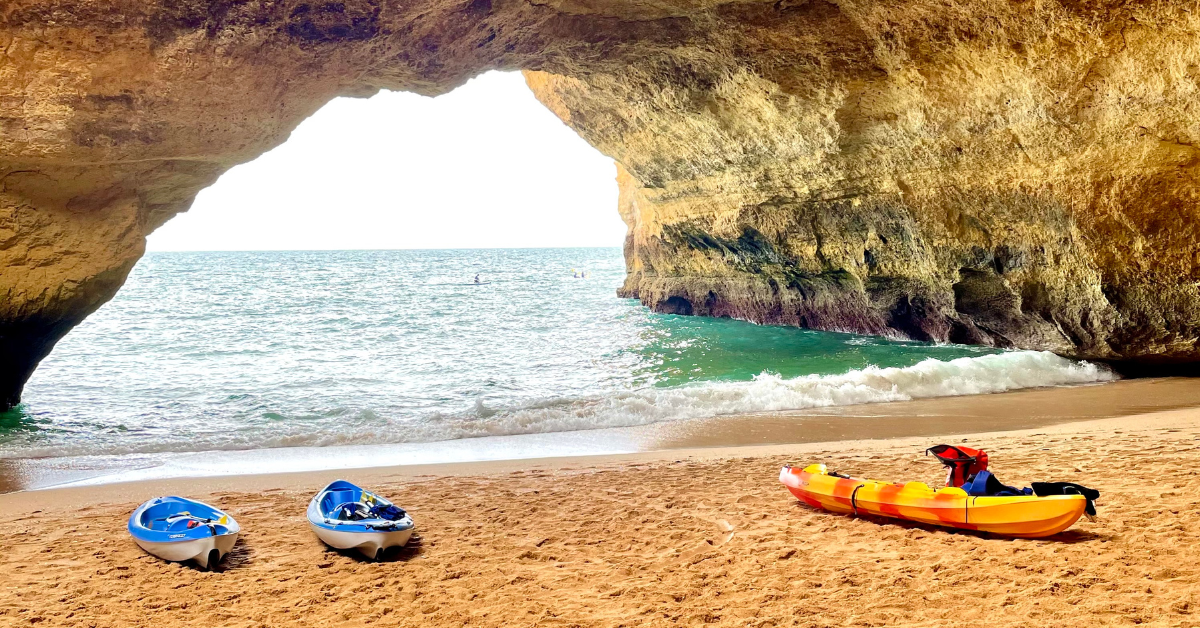Phuket Sea Caves – Kayak Through Natural Marvels

The emerald waters surrounding Phuket hide one of Thailand’s most extraordinary natural wonders: a labyrinth of sea caves carved into ancient limestone karsts. These geological masterpieces, sculpted over millions of years by the relentless forces of tide and time, create a mysterious world where darkness gives way to hidden lagoons of breathtaking beauty. Exploring these caves by kayak offers an adventure unlike any other—a journey through nature’s secret passageways into sheltered worlds that remained undiscovered until relatively recently. This guide reveals everything you need to know about Phuket’s magnificent sea caves and how to experience them through the perfect combination of vessel and environment: the sea kayak.

The Geological Marvel of Phuket’s Sea Caves
How Sea Caves Form: Nature’s Patient Sculptor
Phuket’s sea caves represent the culmination of geological processes spanning millions of years. Understanding their formation adds depth to the exploration experience:
- Ancient Origins: The limestone that forms these caves began as coral reefs and marine sediments some 250-350 million years ago during the Permian period.
- Mountain Formation: Tectonic forces gradually lifted these ancient seabeds, transforming them into the towering karst formations that now characterize Phang Nga Bay and surrounding waters.
- Water’s Patient Work: The boundary between sea and stone became the canvas for nature’s artistry. Slightly acidic seawater began dissolving the limestone along cracks and weaknesses.
- Mechanical Erosion: Wave action physically wore away at the rock, particularly during storms and king tides, accelerating the carving process.
- Cave Development: Over countless millennia, these forces hollowed out chambers and tunnels, creating the complex network of sea caves we can explore today.
- Hong Formation: In many cases, the ceilings of larger cave chambers collapsed, creating the distinctive “hongs” (Thai for “rooms”)—hidden interior lagoons completely encircled by limestone walls but open to the sky above.
This ongoing process—limestone dissolving at approximately 1mm per year—means the caves we explore today are still evolving, with new passages forming and existing ones gradually expanding.
Types of Sea Caves Around Phuket
Phuket’s maritime landscape features several distinct cave formations, each offering unique experiences:
1. Throughway Caves
These tunnel-like formations pass completely through narrow sections of limestone islands. Kayakers enter from one side, navigate a dark passage, and emerge on the opposite side. Famous examples include:
- Talu Island Cave: A 50-meter passage that becomes completely dark in its central section
- Koh Phanak Throughway: Allows paddlers to traverse entirely through a limestone outcropping
- Bat Cave (Tham Lod): Named for its resident bat colonies visible on the cave ceiling
2. Hong Access Caves
The most magical of Phuket’s cave types, these passages serve as gateways to hidden interior lagoons (hongs). After navigating through sometimes narrow and low-ceiling tunnels, kayakers emerge into spectacular open-air chambers completely encircled by vertical limestone walls. Notable examples include:
- Hong Island (Koh Hong): Features multiple access caves leading to a stunning central lagoon
- Panak Island Hongs: Home to several impressive cave systems opening into lush interior lagoons
- Diamond Cave: Named for light-reflecting calcite deposits on the walls
3. Tidal Caves
These dramatically changing caves are fully accessible only during specific tide levels:
- Oyster Cave: Almost completely submerged at high tide, reveals its full chamber only as waters recede
- Mangrove Cave: Accessible through a low entrance that disappears entirely during high water
- Ice Cream Cave: Named for stalactite formations resembling melting ice cream, requires precise tidal timing
4. Cathedral Caves
Characterized by their large, open chambers with impressive height:
- Skull Cave: Features a large cathedral-like main chamber with haunting acoustics
- Viking Cave: Known for its size and historical use by swiftlet nest collectors
- Emerald Cave: Combines a dark passage with a strikingly beautiful interior beach
Top Locations for Sea Cave Kayaking
1. Phang Nga Bay: The Premier Destination
Located northeast of Phuket in the Andaman Sea, Phang Nga Bay contains the highest concentration of accessible sea caves in Thailand. This protected bay, with its iconic limestone karsts rising dramatically from emerald waters, offers dozens of cave systems to explore. James Bond Island (Koh Tapu), made famous through “The Man with the Golden Gun,” serves as the recognizable landmark, but the real treasures lie in the less photographed caves and hongs throughout the bay.
Highlight Caves:
- Hong Island’s complex of four interconnected lagoons
- Panak Island’s Ice Cream Cave with its distinctive melting formations
- Diamond Cave’s glittering calcite-covered walls
- Bat Cave’s impressive throughway tunnel with resident bat colonies
2. Koh Hong (Krabi): The Emerald Lagoon
While technically in neighboring Krabi Province, Koh Hong is accessible as a day trip from Phuket and offers one of Thailand’s most spectacular hong experiences. Unlike many caves requiring narrow access tunnels, Koh Hong features a relatively wide entrance channel that opens into an extraordinary sheltered lagoon with striking emerald waters.
What Makes It Special:
- Exceptional water clarity creating mesmerizing emerald hues
- Surrounding walls rising over 100 meters
- Rich marine life visible directly from your kayak
- Combination of cave exploration and excellent snorkeling opportunities
3. Koh Yao Noi & Yao Yai: Less-Visited Wonders
These twin islands between Phuket and Krabi feature several impressive but less-frequented cave systems, offering more solitary exploration opportunities:
Notable Caves:
- Eastern Koh Yao Noi’s hidden channel caves
- Southern Koh Yao Yai’s daylight caves with stalactite formations
- Several unnamed caves known primarily to local guides
4. Local Phuket Caves
Several smaller but still impressive cave systems can be found closer to Phuket itself:
- Koh Siray: Small caves along the eastern coastline of this connected island
- Naka Island: Brief but interesting cave formations a short paddle from Phuket’s northeast coast
- Cape Panwa: Southern caves accessible during calm sea conditions

The Kayaking Experience: Why It’s the Perfect Vessel
Of all the ways to explore sea caves, kayaking offers unparalleled advantages:
1. Access to the Inaccessible
Kayaks can navigate passages too narrow, shallow, or low for larger boats. Many of the most spectacular hongs remain completely inaccessible except by kayak, as their entrance tunnels feature ceiling heights that require passengers to lie almost flat during passage.
2. Minimal Environmental Impact
The silent, human-powered approach of kayaks minimizes disruption to these fragile ecosystems. Without engine noise or propeller wash, wildlife is less disturbed, and the delicate cave environments suffer less erosion and pollution.
3. Immersive Perspective
The water-level vantage point of a kayak creates a more intimate connection with the environment. Paddling just inches above the water surface heightens the sensory experience—from the echo of water drips in cave passages to the towering scale of limestone walls.
4. Freedom of Movement
Unlike larger vessels restricted to deeper channels, kayaks can explore shallow areas, pause directly beneath interesting formations, and maneuver into the most photogenic positions for capturing the experience.
5. Silent Observation
The quiet approach of kayaks allows for wildlife encounters that would be impossible with motorized transport. Monkeys, kingfishers, egrets, and monitor lizards often continue their natural behaviors undisturbed by the silent presence of kayakers.
Guided Tours vs. Independent Exploration
Guided Tour Advantages
For most visitors, guided tours provide the optimal sea cave experience:
- Local Knowledge: Professional guides understand tidal patterns determining when caves are safely accessible
- Safety Support: Tours include support boats, first aid capabilities, and emergency protocols
- Educational Value: Knowledgeable guides explain the geological, ecological, and cultural significance of these environments
- Equipment Quality: Tours provide appropriate kayaks specifically designed for sea cave navigation
- Convenience: All logistics, from transportation to meals, are handled for you
Independent Exploration Considerations
While self-guided cave kayaking is possible for experienced paddlers, several important factors should be considered:
- Tidal Hazards: Miscalculating tides can lead to being trapped in caves or unable to enter passages
- Navigation Challenges: Many caves look similar from the outside with entrances difficult to identify
- Equipment Limitations: Rental kayaks available directly from beaches are rarely suitable for proper cave exploration
- Access Restrictions: Some areas require national park fees and permits
- Safety Concerns: Independent paddlers lack the support systems of guided tours
Recommendation: First-time cave explorers should always begin with guided experiences before considering independent adventures. Even experienced kayakers benefit from local guides’ knowledge during initial visits.
Types of Sea Cave Kayaking Tours
1. Standard Day Tours
The most popular option featuring:
- Exploration of 3-5 different cave systems
- Full Thai lunch served on board the support vessel
- 7-8 hour total duration
- Typically priced from 2,000-3,500 THB per person
- Suitable for most ages and fitness levels
Best For: First-time visitors wanting a comprehensive introduction to the region’s caves
2. Hong by Starlight
John Gray’s signature tour featuring:
- Afternoon start continuing into evening
- Krathong (floating flower offering) crafting and ceremony
- Paddling in caves at sunset
- Opportunity to see bioluminescent plankton (seasonal)
- Premium Thai dinner
- Higher price point (3,500-4,500 THB per person)
Best For: Those seeking a more magical, cultural experience beyond basic sightseeing
3. Specialized Photography Tours
Designed for serious photographers with:
- Optimal timing for light conditions
- Extended time in the most photogenic locations
- Smaller groups for unobstructed shooting
- Technical advice from guides with photography expertise
- More flexible itineraries based on lighting and conditions
Best For: Photography enthusiasts wanting to capture these environments in optimal conditions
4. Private Charters
Customized experiences featuring:
- Exclusive boat just for your group
- Flexible itinerary and timing
- Premium food options
- Higher guide-to-guest ratio
- Significantly higher price point but ideal for special occasions
Best For: Families, special celebrations, or those seeking a more personalized experience
What You’ll Discover Inside the Caves
Geological Formations
The limestone caves showcase nature’s sculptural capabilities through various formations:
- Stalactites: Hanging calcite formations created as mineral-rich water drips from cave ceilings over thousands of years
- Stalagmites: Upward-growing formations that sometimes meet stalactites to form columns
- Flowstone: Smooth, flowing mineral deposits that create rippled patterns along cave walls
- Calcite Curtains: Thin, wavy formations resembling draped fabric
- Helictites: Twisted formations that seem to defy gravity, growing in multiple directions
Unique Ecosystems
Sea caves and hongs harbor specialized ecological communities adapted to these unique environments:
- Cave-Adapted Invertebrates: Small crustaceans and insects specialized for low-light conditions
- Swiftlet Nests: Some caves host the birds whose nests are used in Chinese bird’s nest soup
- Bat Colonies: Several caves provide habitat for insectivorous bats
- Specialized Plants: Adapted to low light and brackish water conditions
- Mangrove Miniatures: Stunted mangrove ecosystems thriving in the protected interior lagoons
Marine Life
The waters within and around sea caves often harbor rich marine communities:
- Cave Shrimp: Nearly transparent crustaceans adapted to cave environments
- Juvenile Fish: Caves and hongs serve as nursery areas for multiple fish species
- Sea Snakes: Occasionally spotted resting in quieter cave sections
- Oysters and Mussels: Frequently attached to lower cave walls in the intertidal zone
- Bioluminescent Plankton: In some locations, particularly during darker moon phases
Wildlife Encounters
The protected nature of hongs creates havens for various wildlife:
- Crab-Eating Macaques: Troops frequently visible along the hong walls
- Monitor Lizards: These large reptiles often bask on rocks or swim across lagoons
- Kingfishers: Several species including the vibrant collared kingfisher
- Sea Eagles: Nesting in the higher reaches of the limestone walls
- Hornbills: Occasionally spotted in trees along the upper edges of hongs
Best Times for Sea Cave Exploration
Seasonal Considerations
- November to April (Dry Season): Ideal conditions with calm seas, better visibility, and more reliable weather. December through February offers the most consistent conditions.
- May and October (Shoulder Seasons): Variable but often good conditions with fewer crowds. Occasional rain showers but typically brief.
- June to September (Monsoon Season): More challenging conditions with rougher seas and reduced visibility. Some caves become inaccessible due to high swells, though sheltered locations may remain viable.
Tidal Timing
Perhaps more important than the season is the specific tidal condition:
- Low to Mid Tide: Many caves are only accessible when water levels permit passage through low entrances
- Rising Tides: Can create hazardous conditions where caves might become sealed with paddlers inside
- King Tides: Extreme high tides can completely submerge some cave entrances
Professional tour operators schedule their departures based on optimal tidal conditions for the specific caves they plan to visit—one of the many advantages of guided experiences.
Preparing for Your Sea Cave Kayaking Adventure
Essential Items to Bring
- Quick-Dry Clothing: Lightweight shorts and t-shirt or rash guard that won’t become uncomfortable when wet
- Sun Protection: High-SPF reef-safe sunscreen, hat with chin strap, sunglasses with strap
- Water Shoes: Comfortable footwear that can get wet (some tours provide these)
- Waterproof Camera/Phone Case: Essential for capturing the experience
- Small Dry Bag: For keeping valuables protected
- Insect Repellent: Particularly important for hong exploration and evening tours
- Change of Clothes: Keep in the support boat for after your cave adventures
What Tour Operators Typically Provide
- Kayaks and paddles specifically designed for sea cave navigation
- Life jackets (mandatory for all participants)
- Basic dry bags for small valuables
- Meals and refreshments (varies by tour type)
- Hotel transfers (with most operators)
- Professional guides with local knowledge
- Safety and emergency equipment
Safety and Environmental Considerations
Cave Safety Essentials
Sea cave exploration carries inherent risks that quality operators manage carefully:
- Tide Awareness: Professional guides understand the narrow windows when caves are safely passable
- Helmet Use: Some operators provide helmets for passages with lower ceilings
- Guide Communication: Clear systems for communicating within dark cave environments
- Emergency Protocols: Established procedures for various scenarios
- Medical Preparation: Guides trained in wilderness first aid
Environmental Responsibility
The fragile ecosystems of sea caves face increasing pressure from tourism. Responsible visitors can help preserve these environments by:
- No-Touch Policy: Never touching cave formations, as oils from human skin damage stalactites
- Quiet Voices: Keeping volume low to avoid disturbing wildlife, particularly in echo-prone caves
- Zero Waste: Taking all trash back to the support boat, including organic matter
- Stay in Kayaks: Remaining in vessels rather than attempting to walk in sensitive areas
- Wildlife Distance: Maintaining appropriate space from animals, especially nesting birds
Supporting Conservation
Choose operators demonstrating commitment to these environments through:
- Smaller group sizes that reduce impact
- Educational components explaining ecosystem fragility
- Waste reduction practices and plastic alternatives
- Support for local conservation initiatives
- Employment and fair payment of local guides

Magical Moments: What Makes Sea Cave Kayaking Unforgettable
What elevates sea cave kayaking from simple sightseeing to transformative experience are the moments of genuine wonder that occur throughout these adventures:
The Darkness-to-Light Revelation
The journey from dark, enclosed cave passage into a sunlit hong creates a powerful contrast—a sudden transition from confinement to spacious beauty that many describe as literally breath-taking.
The Perfect Silence
In the center of a hong, far from engines and crowds, periods of complete silence allow connection with these environments in a meditative way impossible in most tourist experiences.
The Living Ceiling
Looking up from your kayak at the vertical limestone walls soaring hundreds of feet overhead, often draped with vines and vegetation, creates a cathedral-like atmosphere of natural grandeur.
The Time-Travel Sensation
Realizing you’re witnessing geological processes spanning millions of years creates a humbling perspective shift about humanity’s brief existence compared to these ancient landscapes.
The Shared Wonder
The expressions of amazement shared between paddling companions as they emerge into a hong together often become cherished memories of genuine, unscripted joy.
Beyond the Standard Experience: Specialized Sea Cave Adventures
For those seeking deeper engagement with these environments, several specialized experiences are available:
Geology-Focused Expeditions
Tours led by guides with specific geological expertise:
- Detailed explanations of karst formation processes
- Identification of different limestone types and ages
- Exploration of more technical aspects of cave development
- Specialized sites showcasing particular geological features
Night Bioluminescence Tours
Evening expeditions focused on witnessing bioluminescent plankton:
- Timing coinciding with darker moon phases
- Special attention to locations with higher plankton concentrations
- Extended time in areas allowing interaction with this natural phenomenon
- Photography guidance for capturing this challenging subject
Extended Cave-to-Cave Expeditions
Multi-day journeys exploring numerous cave systems:
- Overnight stays on support vessels or island accommodations
- Access to more remote, less-visited cave systems
- Opportunity to revisit locations at different tide levels and light conditions
- More comprehensive exploration of the region’s geological diversity
Conclusion: Unmissable Natural Wonder
Phuket’s sea caves represent one of Southeast Asia’s most remarkable natural attractions—geological wonders that combine adventure, beauty, and the thrill of discovery in perfect measure. The experience of silently gliding through a dark limestone tunnel that suddenly opens into a hidden world of luminous water and towering walls creates the kind of travel memory that remains vivid long after other experiences have faded.
What makes these adventures particularly special is their accessibility—available to almost anyone regardless of age or physical ability thanks to the guided nature of most tours. Unlike many adventure activities requiring special skills or exceptional fitness, sea cave kayaking welcomes virtually all travelers to witness these geological masterpieces firsthand.
For visitors to Phuket seeking experiences beyond beaches and nightlife, the sea caves offer something increasingly precious in modern tourism: genuine moments of wonder and discovery. In an age where most destinations are thoroughly documented online before arrival, paddling through a limestone tunnel into a hidden hong still delivers that rare, authentic sensation of exploring something truly extraordinary—a reminder of why we travel in the first place.











